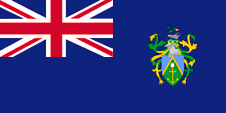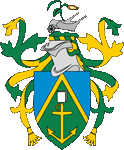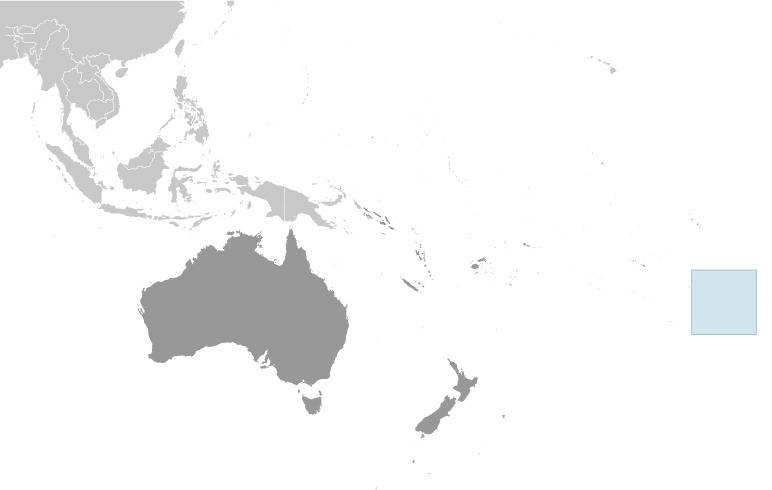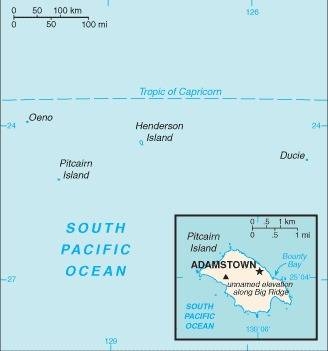mobile View, to the German Version tap the flag


- Pitcairn and Dependencies
- possession of United Kingdom
- own name: Pitcairn and Dependencies
• Flag
• Historical Flag
• Meaning/Origin of the Flag
• Coat of Arms
• Meaning/Origin of the Coat of Arms
• Map
• Numbers and Facts
• History
• Origin of the Country's Name

since 1984,
National flag,
ratio = 1:2,
Source, by: Flaggen Enzyklopädie





1838–1984,
Flag of United Kingdom,
ratio = 1:2,
Source, by: Wikipedia (EN)






The national flag of Pitcairn was adopted on 2nd of April in 1984. It6 is a so called "Blue Ensign", a dark blue flag with a flag depiction – the British Union Jack – in the upper left staff quadrant. In the years before, only the British Union Jack was to be used on land and for this purpose. The Union Jack points to the connections to United Kingdom. United Kingdom introduced a flag system in 1864 in which:
• war ships fly the "White Ensign" (naval flag), a white flag often with an uninterrupted red St. George's-Cross and with the Union Jack in the upper staff quadrant of the flag,
• merchant ships fly a "Red Ensign" (also named "Civil Ensign" → civil flag, the real merchant flag), a red flag with the Union Jack in the upper staff quadrant of the flag, and
• governmental ships fly the "Blue Ensign" (flag for the use by the gouvernment → the actual state flag), a blue flag with the Union Jack in the upper staff quadrant of the flag. Since 1865 ships of colonial governments were permitted to fly the Blue Ensign with a badge in the flying end of the flag. The respective governments were asked to design appropriate badges. Merchant ships and seafaring persons from colonies were only permitted to use the Red Ensign with a badge, then also named Civil Ensign, if permission has been given to the respective colony by the British admiralty. Pitcairn used that possibility very late. The today’s flag was introduced not until 1984. Such a badge was often a regional landscape representation placed on a disk, often showing ships, historical events or even a kind of a logo. Very often, a badge also showed the name of the country or a motto. Some British possessions, however, already had a coat of arms from the beginning, or their badge was replaced by a coat of arms over the years. To ensure a uniform appearance in the flying end of the flags, coats of arms and other symbols were displayed on a white disk in the size of the earlier badges. There were also exceptions, because some colonies did not use the white disk and placed their escutcheon or even coat of arms directly on the bunting, sometimes enlarged. Already in the '40s they started to remove the white disk and placed the coat of arms directly or enlarged. This conversion process was done gradually, nowhere at the same time and completely. In some British possessions, flags with the white disc are still in use, in others no more and in some areas are both variants in use, next to each other.
Source: Flags of the World,
Die Welt der Flaggen,
Flaggen Enzyklopädie


Coat of arms of Pitcairn,
Source, by:
Flags of the World

The coat of arms was awarded to the island on the 4th of November in 1969. The blazon shows a green point with a golden border on blue ground. It should symbolize Pitcairn Island which protrudes as a precipitous rock out of the ocean. In the green point are placed an anchor (the anchor of the "Bounty") and a book (the bible of the "Bounty"). The blazon is surrounded by an abundant helmet decoration in the colours gold and green. On the helmet a handbarrow (memory to the first settlers) with a "Portia Tree" (Thespesia populnea). It is important for the folkloreistic wood carvings of the islanders.
Source: Wikipedia (EN),
Flaggen Enzyklopädie

Location:

Source: CIA World Factbook
Map of the country:

Source: CIA World Factbook

Area: 18,5 square miles, thereof Pitcairn 1,73 sq.mi.,
and the Dependencies:
Henderson 12,35 sq.mi., uninhabited,
Atoll of Ducie 2,5 sq.mi., uninhabited,
1,93 sq.mi., uninhabited
Inhabitants (only on Pitcairn): 47 (2021)
Density of Population (only Pitcairn): 27 inh./sq.mi.
Main Place: Adamstown
Seat of Administration: Auckland (New Zealand)
official Languages: Pitkern, English
Currency: New Zealand Dollar (NZ$) = 100 Cents
Time Zone: GMT – 8 h
Source: Wikipedia (DE),
Wikipedia (EN)

Pitcairn
Middle Ages · settlement by Polynesians, but probably not permanent inhabited and soon abandoned
2nd of July 1767 · the British seafarer Philip Carteret discoveres the island, and names it by his Ensign Robert Pitcairn which spoted the island as first, the position was calculated with mistakes and the island was not to find again anymore
15th of January 1790 · the mutineers of the "Bounty" find accidentally the forgotten island, land on it and establish a smallholding with natives from Tahiti
1808 · the US-American seafarer and whaler Mathew Folger discovers as first the mutineers of the "Bounty", from its initial crew is only John Adams still alive
17th of September 1814 · arrival of two British warships, after view of the small and peaceful community they returned without having achieved anything
1823 · one new European settler settles on Pitcairn
1828 · one further new European settler settles on Pitcairn
1831 · all inhabitants of Pitcairn become relocated to Tahiti, several death by diseases under the Pitcairn-Islanders
September 1831 · 65 Pitcairn-Islanders return to their island
30th of November 1838 · the Pitcairn-Islanders sign the constitution of the island on board of the British whaling-ship Fly, the island becomes in this way indeed a British colony but is also subordinated under the protection of the British Empire
1845 · Pitcairn has 156 inhabitants
1856 · Pitcairn has 194 inhabitants
8th of June 1856 · because of feared famines the Pitcairn-Islanders become relocated to the Norfolk Island (hereafter they become named "Islanders")
1858 · 16 Pitcairn-Islanders return from Norfolk to their island
1864 · four further families of Pitcairn-Islanders return from Norfolk to their island
Second World War · the British navy stations radio-observers
2004 · "Pitcairn Rape Process", the half of all men of the island becomes convicted as guilty, the sentence is however postponed because the existence of the island's community is in danger
Henderson
Middle Ages · settlement by Polynesians, but probably not permanent inhabited and soon abandoned
29th of January 1606 · the Portugese seafarer Pedro Fernandez de Quiros discovers the island and names it "San Juan Bautista", but its position fell into oblivion
17th of january 1819 · the British seafarer James Henderson discovers the island again, the island gets his name
1820–1821 · shipwrecked people of the US-American whaler "Essex" live more then 100 days on the island
ca. 1890–1910 · attempts for phosphate-mining
1902 · Henderson Island becomes officially appropriated by United Kingdom and incorporated into the British Empire together with Oeno Island and the Atoll of Ducie
Oeno
1819 · the British seafarer James Henderson discovers the island
26th of January 1824 · the US-American seafarer and whaler George B. Worth land with his ship "Oeno" on the island, the island gets its name from the ship
1858 · shipwrecked people of the US-American ship "Wild Wave" live more then 200 days on the island
1902 · Oeno Island becomes officially appropriated by United Kingdom and incorporated into the British Empire together with Henderson Island and the Atoll of Ducie
Atoll of Ducie
(consisting of Acadia Island, Westward Island, Pandora Island and Edwards Island)
1606 · the Portugese seafarer Pedro Fernandez de Quiros discovers the atoll and names it "Encarnacion" (by other sources "Luna Puesta"), but its position fell into oblivion
1791 · the British seafarer Edward Edwards with his ship "Pandora" discovers during the search for the mutineers of the "Bounty" the atoll again, he names the islands by Thomas Moreton Reynolds the 2nd Lord Ducie of Tortworth
1881 · shipwrecked people of the British ship "Acadia" land momentary on those island which since then is called by the name of that ship
1902 · the Atoll of Ducie becomes officially appropriated by United Kingdom and incorporated into the British Empire together with the Islands of Henderson und Oeno
Source: Wikipedia DB Sonderband, Frühjahr 2005

The name "Pitcairn" has its roots in the Ensign Robert Pitcairn from the sloop "Swallow" under the command of Captain Philip Carteret. Robert Pitcairn spoted the island as the first. He descented from an in Scotland living merchant's family which originally came from Memel in East Prussia.
Source: Wikipedia DB Sonderband, Frühjahr 2005


![]()








